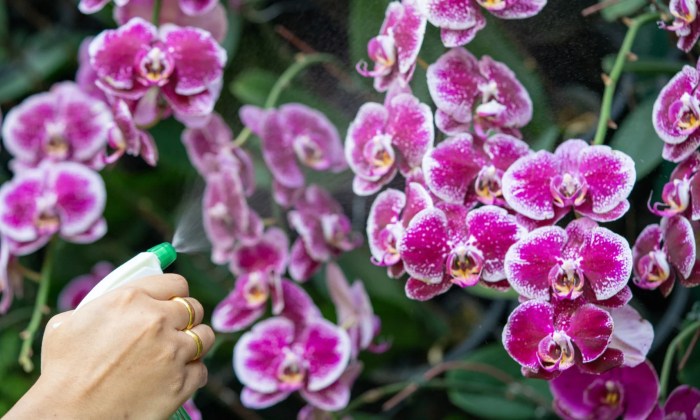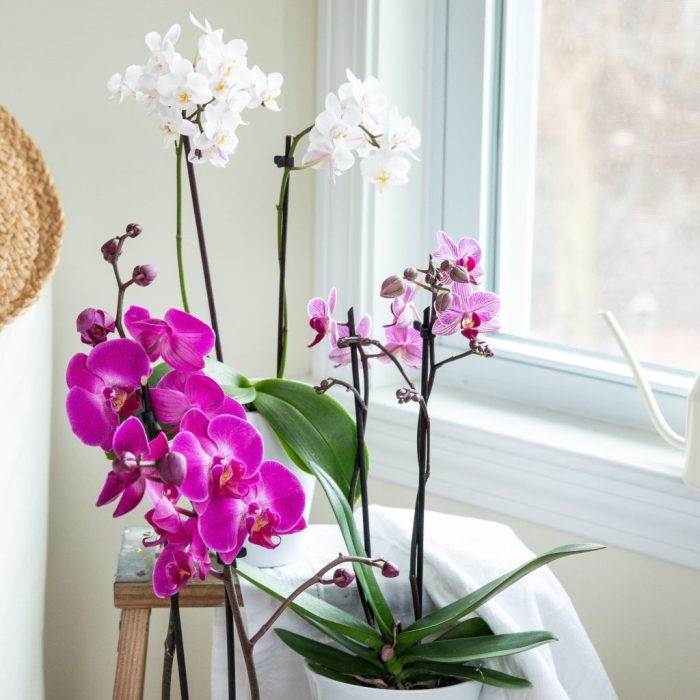Understanding Orchid Watering Needs: How Much To Water An Orchid Plant
How much to water an orchid plant – Proper watering is crucial for orchid health and longevity. The frequency and method depend on several interconnected factors, ensuring a balance between sufficient hydration and preventing root rot.
Factors Influencing Watering Frequency
Several factors determine how often you should water your orchids. These include the specific orchid type, the size and material of the pot, the current season, and the ambient environment.
- Orchid Type: Different orchid species have varying water requirements. Phalaenopsis orchids, for example, prefer consistently moist but not soggy conditions, while Cattleyas appreciate a more pronounced drying period between waterings.
- Pot Size and Material: Larger pots retain moisture longer than smaller ones. Clay pots, being porous, dry out faster than plastic pots.
- Season: Orchids generally need more frequent watering during their active growing season (typically spring and summer) and less during dormancy (fall and winter).
- Environment: High temperatures and low humidity accelerate drying, necessitating more frequent watering. Conversely, cooler temperatures and higher humidity reduce the need for frequent watering.
Signs of Underwatering and Overwatering
Recognizing the signs of underwatering and overwatering is key to maintaining healthy orchids. Visual cues can help you adjust your watering practices.
- Underwatering: Leaves will appear shriveled, wrinkled, or limp. The potting mix will be completely dry to the touch. Pseudobulbs (if present) may appear soft and wrinkled.
- Overwatering: Leaves may yellow, become mushy or develop brown spots. The potting mix will remain consistently damp or soggy. Roots may appear brown, mushy, and possibly smell foul.
Watering Needs Comparison for Different Orchid Types
The following table provides a general guideline for watering frequency for different orchid types. Remember that these are just estimates, and individual needs may vary.
| Orchid Type | Watering Frequency (Summer) | Watering Frequency (Winter) | Watering Method Preference |
|---|---|---|---|
| Phalaenopsis | Once every 7-10 days | Once every 14-21 days | Soaking or bottom watering |
| Dendrobium | Once every 5-7 days | Once every 10-14 days | Soaking or top watering |
| Cattleya | Once every 5-7 days | Once every 14-21 days | Soaking |
| Oncidium | Once every 5-7 days | Once every 10-14 days | Soaking or top watering |
Watering Methods and Techniques
Several methods can effectively water orchids, each with its advantages. The key is to ensure even moisture distribution and prevent waterlogging.
Step-by-Step Orchid Watering Guide
This guide details the process of properly watering your orchids using different methods.
- Soaking: Immerse the entire pot in a container of water for 15-30 minutes, ensuring the potting mix is thoroughly saturated. Allow excess water to drain completely before returning the orchid to its usual location.
- Top Watering: Gently pour water over the potting mix, allowing it to soak in gradually. Avoid getting water on the leaves, especially the crown, to prevent rot. Water until you see a small amount of water draining from the drainage holes.
- Bottom Watering: Place the pot in a container of water, allowing the water to wick up into the potting mix from the bottom. Let it sit for 15-30 minutes, then remove and allow excess water to drain.
Visual Guide to Proper Watering Techniques

Source: brilliantorchids.com
Imagine a visual guide with three panels. The first panel shows the soaking method, with the orchid pot fully submerged in a container of water. The second panel depicts top watering, carefully pouring water over the potting mix, avoiding the leaves. The third panel demonstrates bottom watering, with the orchid pot sitting in a shallow dish of water, allowing the water to absorb from below.
Each panel would have a descriptive caption summarizing the method.
Tips for Even Watering and Preventing Waterlogging
To ensure even watering and prevent waterlogging, always allow excess water to drain completely after watering. Use a pot with adequate drainage holes. Check the potting mix regularly to determine when it’s time to water again.
Watering Schedule and Frequency
Establishing a consistent watering schedule tailored to your orchid’s type and environmental conditions is vital. Remember to adjust the schedule based on seasonal changes.
Ideal Watering Schedule Based on Growth Cycles and Environment
The ideal watering schedule varies greatly depending on the orchid species, its growth stage, and the ambient temperature and humidity. For example, actively growing orchids in warm, dry conditions will require more frequent watering than dormant orchids in cool, humid conditions.
Adjusting Watering Frequency According to Seasonal Changes
During warmer months (spring and summer), orchids generally require more frequent watering due to increased evaporation. Conversely, during cooler months (fall and winter), reduce watering frequency to prevent root rot.
Sample Watering Schedule for a Phalaenopsis Orchid
This schedule provides a general guideline. Always adjust based on your specific orchid’s needs and environmental conditions.
- Spring (March-May): Water every 7-10 days.
- Summer (June-August): Water every 5-7 days.
- Autumn (September-November): Water every 10-14 days.
- Winter (December-February): Water every 14-21 days.
Water Quality and its Impact
The quality of water used to irrigate orchids significantly impacts their health and growth. Using the right type of water can prevent mineral buildup and other issues.
Characteristics of Ideal Water for Orchids
Ideally, orchid water should be slightly acidic (pH 5.5-6.5) and low in minerals and salts. High mineral content can lead to salt buildup in the potting mix, hindering root function.
Comparison of Water Types
Tap water often contains chlorine, fluoride, and minerals that can harm orchids. Filtered water removes these impurities, making it a safer option. Rainwater is generally ideal, provided it’s collected in a clean container away from pollutants.
Impact of Water Hardness and Salinity
Hard water, high in minerals like calcium and magnesium, can lead to salt buildup in the potting mix, hindering nutrient uptake and causing leaf tip burn. High salinity from excessive use of fertilizers or poor-quality water can also damage roots and stunt growth. For example, a buildup of salts might manifest as white crusty deposits on the potting media surface.
Troubleshooting Watering Issues
Addressing common watering problems promptly can prevent significant damage to your orchids. Recognizing the symptoms and taking corrective action is essential.
Troubleshooting Guide for Common Watering Problems
| Symptom | Cause | Solution | Prevention |
|---|---|---|---|
| Yellowing Leaves | Overwatering or underwatering, nutrient deficiency | Adjust watering frequency, check for root rot, fertilize appropriately | Monitor watering, use balanced fertilizer |
| Root Rot | Overwatering, poor drainage | Repot in fresh, well-draining potting mix, remove affected roots | Use well-draining potting mix, allow for proper drainage |
| Wilting Leaves | Underwatering, extreme temperatures | Water thoroughly, adjust watering frequency, provide shade during hot periods | Monitor moisture levels, protect from extreme temperatures |
| Leaf Tip Burn | High mineral content in water, fertilizer burn | Flush the potting mix with distilled water, reduce fertilizer application | Use filtered or rainwater, follow fertilizer instructions carefully |
Potting Media and its Role in Watering
The potting medium plays a critical role in efficient watering and drainage, directly impacting the orchid’s health. Choosing the right medium is essential.
Importance of Proper Potting Media
A well-draining potting medium is crucial for preventing root rot. It allows for proper aeration, preventing waterlogging and ensuring healthy root development. The medium should retain some moisture but not become waterlogged.
Comparison of Potting Media Options, How much to water an orchid plant

Source: complete-gardening.com
Common orchid potting media include bark, moss, perlite, and charcoal. Bark provides good drainage and aeration. Moss retains moisture, while perlite improves drainage and aeration. Charcoal helps to improve drainage and prevent fungal growth.
Ideal Characteristics of Orchid Potting Mix
The ideal orchid potting mix should be well-draining, airy, and retain some moisture. It should not compact easily and should provide adequate support for the roots. A good mix will allow for even watering and prevent waterlogging.
Essential FAQs
Can I use tap water for my orchids?
Tap water can be used, but ideally, let it sit out for 24 hours to allow chlorine to dissipate. Filtered or rainwater is generally preferred.
Watering orchids correctly is crucial for their health; avoid overwatering, which can lead to root rot. The frequency depends on factors like pot size and the environment, but a good guideline is to water thoroughly only when the potting mix is almost dry. To understand the general principles of plant watering, you might find this helpful resource useful: how much should i water a plant.
Applying these broader principles to your orchids will help you achieve a thriving plant.
How often should I check my orchid’s potting mix for moisture?
Check the potting mix regularly, especially during the growing season. Stick your finger a couple of inches into the mix; if it’s dry, it’s time to water.
What are the signs of root rot?
Signs of root rot include mushy, dark brown or black roots, and a foul odor. Affected roots should be removed and the plant repotted in fresh, dry media.
My orchid’s leaves are yellowing; what could be wrong?
Yellowing leaves can indicate overwatering, underwatering, or a nutrient deficiency. Check the roots and adjust watering accordingly. Consider a balanced orchid fertilizer.
How do I revive an underwatered orchid?
Submerge the pot in lukewarm water for 15-20 minutes until the potting mix is thoroughly saturated. Allow excess water to drain completely before returning the plant to its usual location.
